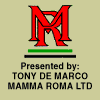Tim Renshaw: A Review by Sacha Craddock
Tim Renshaw paints initially pleasant pictures about the equivalent
of low key frustration, endless cul-de-sacs, flat outskirts of town
and city, pieces with no real centre, situations with no real direction
and a stretch and sprawl which extends way beyond the physical restrictions
of the edge of the canvas. This is no adolescent characterisation of
uniformity and conformity. Instead of setting itself apart and sneering
at the world, this work suggests no separate position or overview. Although
a certain amount of anger is implied it remains within the method of
painting itself. The anger extends, it is hoped, to the way that the
eye will try to make sense and find a way out, only to be thwarted by
confusion, impatience and an ultimate dead end. Instead of choosing an image and then illustrating it, Renshaw is using
many of the accepted and understood methods of painting to build a contemporary
fable. The split between mechanism and methodology, artist and artisan,
is there in the balance between obsessive work and alienation. Although Renshaw's relationship with earlier 'abstract' paintings is
evident in the tactics he uses, these are neither "grid" paintings
nor "all-over" pictures, as such. The vocabulary is different.
The rationale is neither mathematical, 'pure', nor 'free', and the important
role played by detail is never lost in overall visual sensation. The
relation to subject arises much more out of process than anything else.
The paintings instead reach a level of frustration that can bring about
the visual equivalent of repetitive strain injury for both artist and
viewer. The idea of trapped uniformity and the repeat of certain frustrating
patterns is the key. This, also, is in exact opposition to early Modernist
attitudes where images of mechanisation were coupled with a great sense
of optimism for the future. Process alone provides a parallel account of an overall sense of frustration.
It is true that all painting consists of a balance between 'fresh choice'
and 'slavishness'. Here, though, the situation is extreme; every stage
is a matter of degree; each line painstakingly reiterated, re-expressed,
or reinforced is a record of decision. There is a particularly tenuous sense to the haphazard manner in which
threads and mesh from different coloured panels fail to join. The same
dubious quality of quickly xeroxed documents or ill edited scripts churned
out by a perfunctory printer gives the impression of thwarted sense
and evaporated meaning. The frustration at such interference at trying
to grasp words and signs running away separately from any human control
makes an interesting paradox. while technology tries forever harder
to make mechanical reproduction appear more solid and individual, this
painter mimics the disharmony of mechanisation. We see ways of mapping and making sense that are not strictly topographical
as such. No plan or map is really like this. Although each picture has
origins in the structure of plans, newspapers, or even structures of
printed pages, it would be beside the point to match specific details
with individual paintings. As the paintings carry a certain optical or retinal effect, they remind
of one's physical presence and the process of looking. Initial anticipation
of ease and even delight gives way, though, to a sense of annoyance
at flickering waves of ungraspable blur. any expectation of logic or
instruction is soon disappointed. while deliberately powerful and attractive,
the colour arrives out of an accumulation of changes and stages and
already has its own history. Freshness is not really an ingredient. Instead of signs for something or somewhere else the paintings do carry
a rather old-fashioned autonomy in their organisation. while the duality
of doubled blue/grey, yellow/grey, red/white stops any singularity of
direction, it could also provide the notion of a balanced measure of
opposites. Only the earlier 'Red Square' , with its internal spiralling
maze, presents a completely central image. the rest are a great deal
more awkward with their mismatched borders and broken connections. Sacha Craddock
Review of RSI Exhibition at the Winchester Gallery, October 1994.


